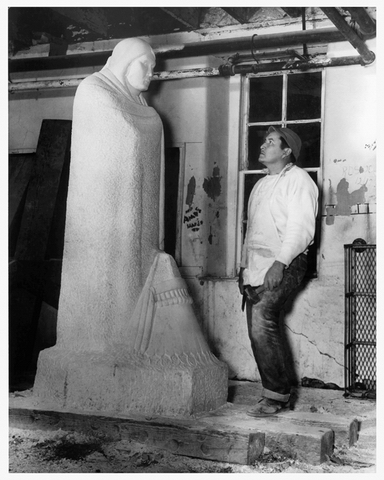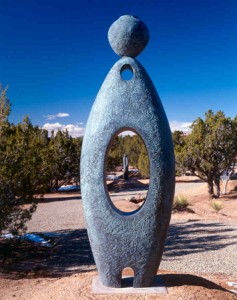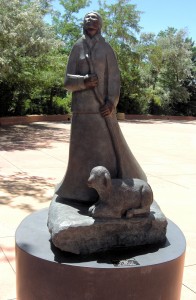Artists
Allan Houser Teaching Spirits Unconquerable

“When I won my Guggenheim fellowship, I said I wanted to become one of the best—whether painter or sculptor—in the world. That’s what my efforts are going to be, whether I get there or not.” ~Allan Houser
Comrade In Mourning 1948 Carrara marble by Allan Houser
Life, Love, Passion
Shelli Carlisle
Born: Allan Capron Haozous
June 29, 1914
Apache, Oklahoma
Died: August 22, 1994
Imagine holding a pencil in your hand and a sketch book propped up on your crossed knee, you began to draw effortlessly. Your drawing comes to life, filled with emotion, beauty and truth. Imagine wrapping your hands around a piece of clay and transforming it into a breathtaking treasure. Imagine standing in front of a huge piece of marble and seeing the story in it before you ever lay a tool against it. This is the gift imparted on Allan Houser.
David Rettig, the curator of Allan Houser, Inc. said, “As my own career in art evolved I concluded that Allan Houser was one of the major American artists of the 20th century. I was lucky to have known him for nearly 20 years. Since beginning my work with his estate, it has been my privilege to delve into the amazing volume of his creativity and try to communicate it to the world.”
With this gift, he created nearly a thousand drawings, paintings, and sculptures. The creations not only tell the story of his family’s plight, but inspire and usher in the art of the future.
Multifaceted
Houser was a passionate man. He loved his wife, his children, and his heritage. He shares this passion with the world through his extraordinary works of art. Paintings, murals, sculpture–small and grand were the vessels through which he spoke with all mankind.
“I’m very anxious most of the time to get into new things and experiment, and see what can be done in other mediums,” Houser said.
Bryan Beasley, writer and director of the award winning documentary Unconquered: Allan Houser and the Legacy of One Apache Family said, “There was nothing Allan couldn’t master. It flowed from him, literally. There really was no limit to what he could do and you really, really see this in his sketches. He sketched all the time, and I think he had over 600 sketch books throughout his life. He would often pull a sketch book from ten years earlier, flip through and see something and say, “I remember this,” and carry that on. Then that would become a piece later down the line. It really never ended.”
Born Free
Houser was the first child of Sam and Blossom Haozous and was born free. The Haozous family along with hundreds of other Apaches, including Spiritual Leader Geronimo, plus Houser’s great grandfather, Warrior Chief Mangas Colorodas, were imprisoned by the United States government for 27 years. Their crime? Simply defending their freedom.
Houser grew up listening to his parents play instruments and sing traditional songs. They also shared with him the stories of generations past. The stories of their ancestors.
Houser said, “I’ve always been very proud about who I am and where I came from because of my mother and dad. I’m a Chiricahua Apache and I’ll tell anybody in the world that I am. It’s good to be who you are. My family name Ha-o-zous means ‘pulling roots out of the ground.’ That refers to the practice of returning thanks to the earth whenever we take something from her. The Indians respected the earth and their deep connection to it, and that’s something to be proud of.”
A Teacher
Houser was a teacher. He believed in giving back to his community. Gifted with boundless talent, he could have taught school at any prestigious university in the country. Instead, he chose to teach art at the Inter-Mountain School in Utah; a boarding school for Indian children. Eleven years later he accepted a position at the newly established Institute of American Indian Arts in Santa Fe, New Mexico.In Santa Fe he shared and inspired hundreds of students. He taught them about finding their own way and utilizing their life experience to uncover and nourish the natural creativity which exists in everyone’s being.
Always working, Houser found time for his own art at night and on the weekends. After thirteen years of teaching at IAIA, he was able to retire and immerse himself in the work his heart had longed to do.
The Dream
Houser desired to create a haven for his art and his family. Together with his son, Phillip Haozous, they designed and constructed a unique fusion of art studios, family homes, dance grounds, amphitheaters and a spacious sculpture garden known as the Houser Compound, near Santa Fe, New Mexico. Houser was very clever when it came to setting up office.Beasley said, “Houser built his office up on a hill where everything else cascaded down. The pieces that were closest to his office were all the abstract pieces, nothing native American. The reason for this was when people would come to interview him—he would always sit on the porch. He wanted his visitors to see that he was more than just doing Indians on the plains.”
Which is why Houser’s art is so unique. His modern pieces are very European. Sleek, polished, undefined, allowing the viewer to only imagine where the artist’s conception begins and the observer’s interpretation ends.
An End, A Beginning
Houser died when he was 80. Throughout his unique life, he received many accolades, awards, and honors. Including the National Medal of Arts Award, which is the nation’s highest honor for artists. It was presented to him by President George Bush.Upon his death, he was still being honored and his work is exhibited and respected worldwide. Among these was the installation of nineteen monumental works of art in Salt Lake City during the 2002 Olympics, and a retrospective of 69 works at the National Museum of the American Indian in Washington, D.C. The exhibition marked the first major show for the new Museum in 2004-2005 and over three million people viewed it during that time.
The Story Lives On
Houser felt very strongly about human dignity for all people, which is clearly apparent in his sculptures. Because of his incredible parents, Houser became the catalyst through which the story of the Chiricahua Apache nation in their survival and triumph over inexplicable odds. Their love, struggles, and endurance are alive through Houser’s work and the works of his children, most notably, Bob Haozous and Phillip Haozous, the baby boomer brothers who are carrying on the Allan Houser legacy, and the story of the Chiricahua Apache Indians.
[nivoslider slug="allan-houser-bob-and-phillip-haozous"]
Tagged Allan Houser, Bob Haozous, Bryan Beasley, Native American Art, Phillip Haozous




Geronimo’s Legacy is Alive, Well, and Kickin Ass in the Art World | Boomer Style MagazineNovember 9, 2012 at 3:26 am
[…] Okla. Two years later in sunny Los Angeles, Calif., Bob Haozous was born. Their father, Allan Houser, moved the family to Los Angeles during WWII to work in the shipyards. When the war ended a few […]
Oklahoma’s Stain Inspires a New Art Form for an Artist | Boomer Style MagazineNovember 7, 2012 at 3:58 am
[…] He found inspiration and the vision to share the past Oklahoma doesn’t give up easily. Which led to the making of his first documentary, Unconquered: Allan Houser and the Legacy of One Apache Family, which is narrated by Val Kilmer. This inspiration led him to work with the Hazous brothers, two baby boomer artists whose talent was passed on to them by their father, world renown artist Allan Houser. […]